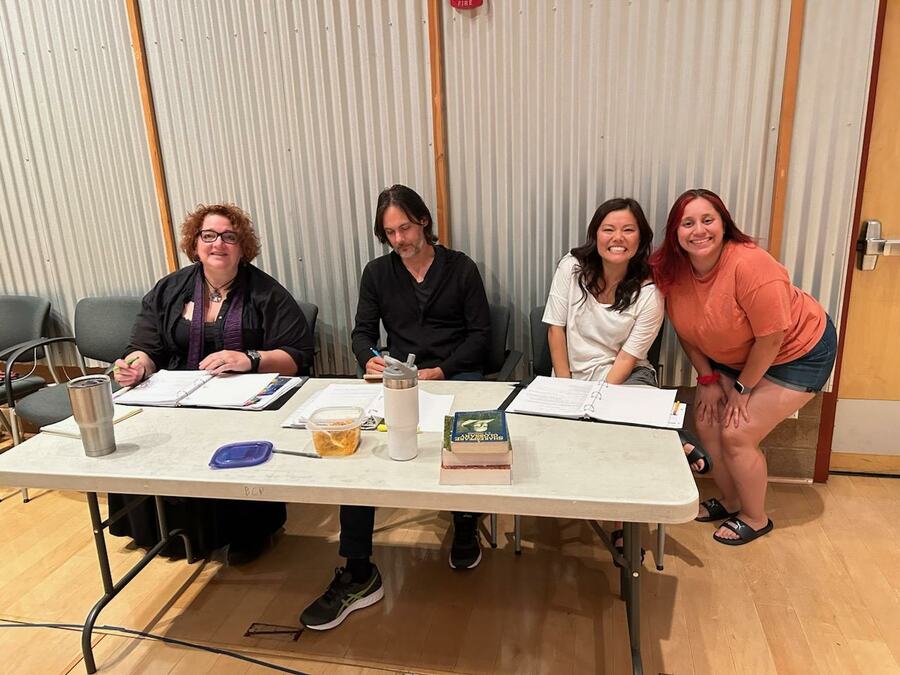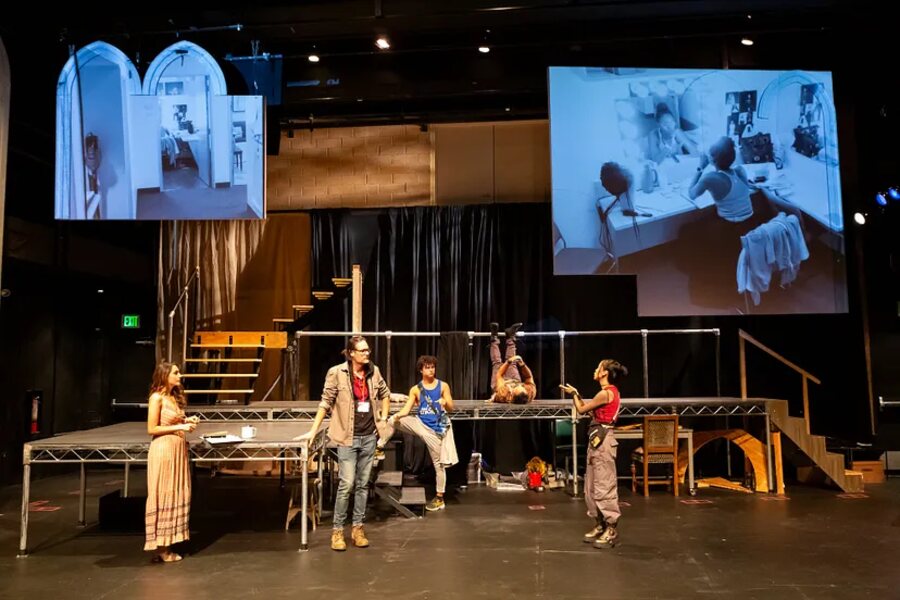“I feel so sorry for people who don’t get to be in rehearsal, because so many wonderful things happen in rehearsal that they will never see in a full performance,” the director Jessica Kubzansky told me last week. She was explaining one of the many impulses behind her new play Measure Still for Measure, an immersive multimedia happening she has staged all over and around the two-theatre campus of Boston Court Pasadena, where it runs through Oct. 22. “I am fascinated by the language that is spoken in rehearsals.”
Some less-than-wonderful things happen in rehearsal too, as pointedly illustrated in Kubzansky’s play, which braids the #MeToo elements of Shakespeare’s thorny Measure for Measure with her own examination of overstepped creative boundaries, as a brilliant white male director who has also cast himself as the play’s Duke crosses a line with the Black actress playing would-be nun Isabella. Tellingly, when Kubzansky gave an example of the kind of backstage drama she wished audiences could see, she cited a prickly moment during the run of a long-ago production of A Flea in Her Ear at a theatre in Austin. One night, an actor who pointedly disagreed with one of her directorial notes left a co-star painfully hanging during a crucial bit of comic business onstage—a moment the audience probably didn’t clock at all but which Kubzansky, knowing the backstory, recalled as “one of the most vicious things I’ve ever seen happen between two actors.”
Another inspiration for her play’s complications is Shakespeare’s 1604 drama, a seeming fable of hypocrisy in which Duke Vincentio ostensibly leaves his city in the hands of a corrupt proxy, Angelo, who mandates strict sexual morality while secretly attempting to force a novitiate, Isabella, into submitting to his advances. Angelo is clearly a villain, though the relative moral position of Vincentio—who sticks around in disguise to see the drama play out among his subjects, only to swoop in at the end, pronounce judgment, and snatch up Isabella as a sort of prize—has always been one of the problems in this so-called problem play.
Measure Still for Measure similarly stages what Kubzansky calls “the intersectional power dynamics of the rehearsal process” by having its fictional director, Bruce Elliot Norton, do an enviable job of shaping performances and bringing text to life—which only makes his later transgressions all the harder to confront, particularly for Dionna, the young woman who is subject to the worst of them.
“I was completely uninterested in writing about Harvey Weinstein, because that is a monster that people know about,” said Kubzansky. “There are tons of warnings about somebody like that. I wanted all these people to be very smart people, with a director who has a really great reputation, deservedly. If the guy is moustache-twirling all over the place, you’ve just made the whole group of actors idiotic. I was trying to write a story with as many shades of grey as there could possibly be—up to a certain point, after which I hope I eliminated some shades of grey.”

The more proximate inspiration for this ambitious meta-theatrical event may be the Boston Court space itself. Kubzansky has been a leader at the 99-seat theatre since its founding in 2003 (her longtime colleague Michael Michetti departed in 2020, leaving her the company’s sole artistic director), and said that ever since she began there, she thought it would be “fascinating to share the whole building immersively and site specifically.” So Measure Still for Measure begins with scenes of actors kibitzing in the parking lot, chatting in the lobby, and warming up in stairwells, and begins in earnest in the theatre’s mainstage, where a rehearsal takes place in front of and around the audience, with video monitors showing private scenes in a nearby rehearsal space and in dressing rooms. The idea is to let the theatre’s loyal audiences “be flies on the wall, to give them an all-access pass” to the unconventional uses the theatre can be put to.
To help make all this possible, Kubzansky said the show got “a huge grant” from the Venturous Theater Fund to support the installation of cameras, and received other grants for the hiring of a nine-person cast. But no amount of funding by itself could work out the daunting logistics of the immersive and multimedia staging.
“I have to say, this is the hardest thing I’ve ever done in the entirety of my creative life,” said Kubzansky, who started out as a writer but over the past three decades has become one of the Southland’s essential stage directors. “That is partly because I was flying the plane as I was building it. I was rewriting daily, and I really needed to take three days off to just rewrite, but I couldn’t because I was also directing the play.” And not just a play, but an intricately timed pre-show with A and B tracks. “I like to say the pre-show ate my homework, just figuring out the three-ring circus timing of that.”
She credits the theatre’s front-of-house team for essentially helping to curate that experience, and effuses over the efforts of the design team, stage management, the tireless cast, dramaturg, and, given the play’s subject matter, the intimacy director—i..e, “the village that it took to make this crazy thing.” Indeed, it seems a fitting way to celebrate the theatre’s 20 years in existence to have its space and its staff become living, breathing characters in themselves.

Did Boston Court, like so many other of the nation’s theatres, almost stop living and breathing over the past few years of lockdown and existential challenge? In fact, the company had already gone through an internal adjustment with the departure of Michetti and a focus on Kubzansky’s singular vision for the programming, which encompasses not only theatre but live music and art exhibitions. And it had weathered sea changes in California labor law in which all contractors, including in small theatres, must be classified as payroll employees. That means, by Kubzansky’s estimation, that while in 2014 Boston Court staged four plays employing 41 actors, as well as more than 25 concerts, for approximately $285,000, that same amount of programming would now cost $1.3 million. This year Boston Court is producing two plays; next year they plan three. (The theatre also hosts other events throughout the year, including National Theatre Live broadcasts.)
Another challenge Kubzansky and the board identified even before 2020: While the theatre had a stellar reputation among L.A. theatregoers, as well on the national new-play scene, it was less well known by average residents of Pasadena and nearby Altadena. So Boston Court, Kubzansky said, used the pandemic lockdown as a time to reach out to local educational institutions, music organizations, libraries, social justice organizations, and community centers for mutual get-to-know-you round tables. They also spent “quality time” during the pandemic with Lisa Mount and Keryl McCord of Artistic Logistics, developing the theatre’s strategic plan and “deepening our commitment to being an anti-racist theatre.” Their community partnerships now include work with community organizers Hood Liberation and My Tribe Rise, the arts education program Light Bringer, and the Altadena public library, where they’ve presented play readings.
Still, reopening has been rocky, as it has been everywhere. As Kubzansky put it, “This is not specific to Boston Court, but the pandemic radically changed people’s habits. They became cave dwellers, and entertainment was wonderful on your couch.”
Some seem to be coming out of their caves for Measure Still for Measure; the show extended its run by a week. “The thing I have valued most is that people have come back to see it again,” Kubzansky said. “I’ve gotten so many emails from people saying how devastated they were—how it sort of crept up on them, how painful and also important it felt to them.”
Could it be that what people will get off their couch for isn’t more or better escapism but something intrinsically theatrical and thematically challenging? As Kubzansky put it, “When we started the whole process, I thought about having the blurb be, ‘A love letter to the theatrical process.’ And then I was like, given what ends up happening in my play, I cannot call it a love letter.”
Rob Weinert-Kendt (he/him) is the editor-in-chief of American Theatre.


